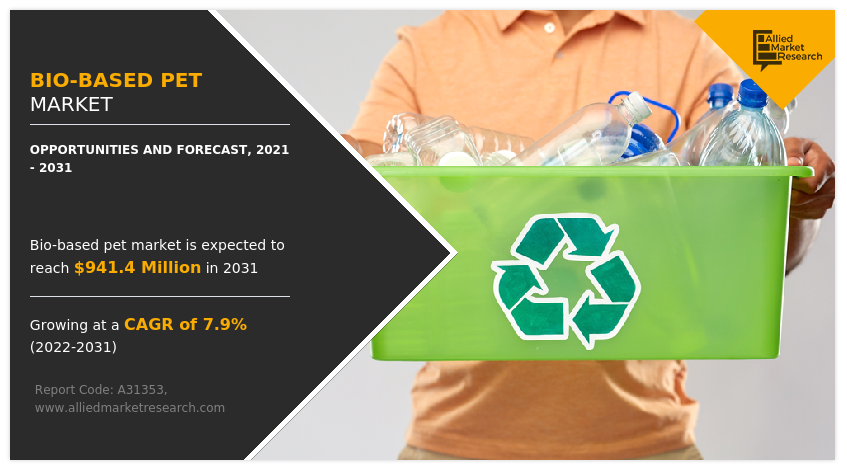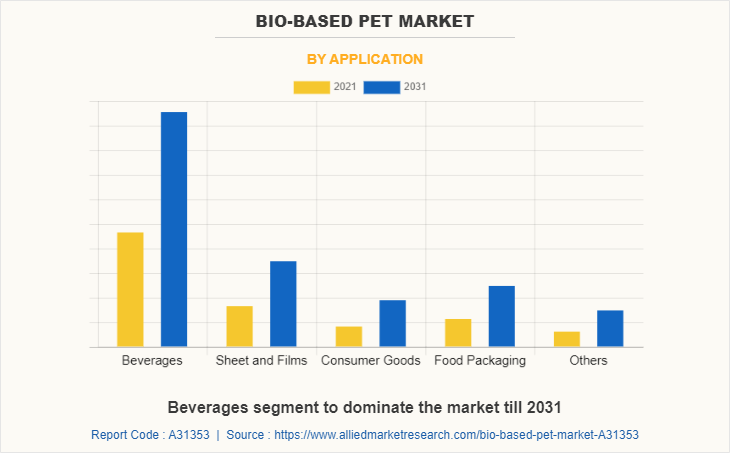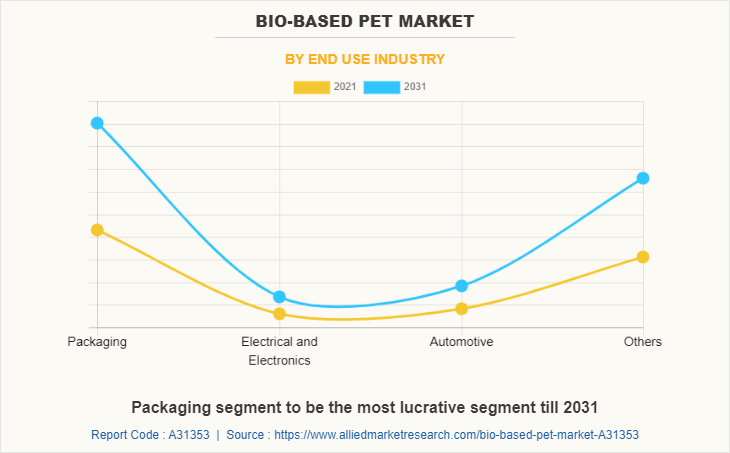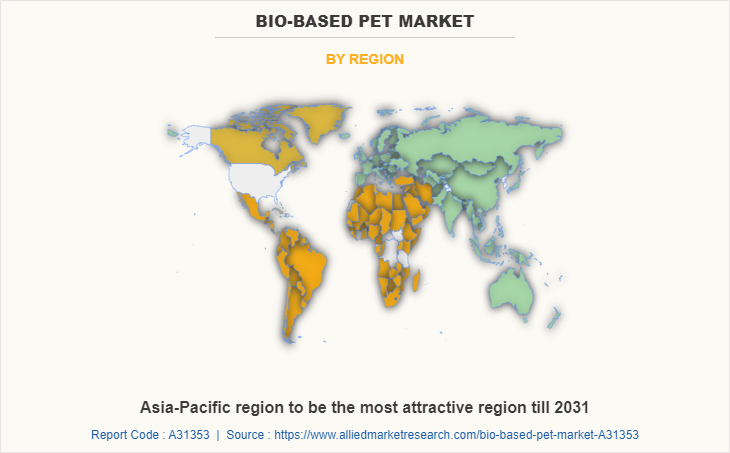Bio-based PET Market Research, 2031
The global bio-based PET market size was valued at $441.3 million in 2021, and bio-based PET industry is projected to reach $941.4 million by 2031, growing at a CAGR of 7.9% from 2022 to 2031.
Polyethylene terephthalate (PET) bio-based is made up of biodegradable materials including mono ethylene glycol (MEG) and terephthalic acid (PTA). It is used in a variety of products, such as construction materials, automobile interiors, bottle manufacture, and packaged goods. The benefits of bio-based PET include non-toxicity, recycling, and a smaller carbon footprint. The automotive, food, and beverage sectors all utilize it extensively. Ethylene The most common thermoplastic polymer resin in the polyester family is polyethylene terephthalate (PET), which is used in textile fibers, beverage and food containers, thermoforming for manufacturing, and engineering resins when combined with glass fiber.

The demand for packaging in the food & beverage industries boosts the growth of the bio-based PET market. Surge in environmental deterioration concerns and the execution of strict government environmental safety legislation are some factors influencing the growth of the market. Furthermore, the market is being viewed favorably because to consumers' increased preference for eco-friendly plastic. The market for bio-based polyethylene terephthalate is anticipated to be driven by rise in costs across a number of industries, including food & beverage, as well as a strict regulatory framework to reduce carbon emissions. The cost of manufacturing bio-based materials, such biofuels and bioplastics, is intolerably high. This is a significant growth inhibitor for the bio-based PET market.
In addition, bioplastics have a longer shelf life, better permeability (important for the packaging of vegetables and fruits), and better recyclability and processability than fossil-based plastics. As a result of these benefits, demand for bioplastics in the Bio-based PET market is experiencing significant increase. However, issues about the cost in comparison to conventional items, as well as recycling, limit the expansion of the market. Compared to fossil-based plastics, bioplastics have a longer shelf life, are more breathable (essential for vegetable and fruit packaging), and are more compostable and renewable. With these advantages, the demand for bioplastics in the bio-based PET market is increasing worldwide. terephthalate around the world.
The bio-based PET market is segmented on the basis of application, end use industry, and region. Depending on application, the market is categorized into beverages, sheet & films, consumer goods, food packaging, and others. On the basis of end-use industry, the market is divided into packaging, electrical & electronics, automotive, and others. On the basis of region, the market is studied across North America, Europe, Asia-Pacific, and LAMEA.

Bio-based PET Market By Application
The beverages segment is projected to have the largest market share in the Bio-based PET market forecast period. The increase in demand from the carbonated soft drink (CSD) market is one of the key factors driving the the global bio-based PET market growth. The Coca-Cola Company and PepsiCo are estimated to be the major companies in the market.

Bio-based PET Market By End Use Industry
The packaging segment is projected to have the largest market share in the bio-based PET market, in 2021. Furthermore, because bio-based polyethylene terephthalate is utilized in water packaging, sweet beverage packaging, fruit juice packaging, beer containers, food containers, and other applications, it is likely to maintain its dominance during the projection period. During the forecast period, all of these factors contribute to the growth of the global bio-based polyethylene terephthalate market.
The construction industry has also stimulated the growth of bio-based PET. For instance, Asphalt is widely used in road pavement construction as the binder of aggregates. However, it is well recognized that asphalt mixture or coating layer shows severe temperature susceptibility such as high temperature rutting, medium temperature fatigue and low temperature cracking damage. Substitutions technique for asphalt in pavements, including the hot mix and the cold mix by polymers such as PET, is put into practice for the improvement of rutting resistance, thermal cracking, fatigue damage, stripping, and temperature susceptibility.

Bio-based PET Market By Region
During the projected period, the Asia-Pacific region is expected to continue to hold the highest share of the Bio-based PET Market. During the projected period, it is also anticipated to increase at the fastest rate. Key businesses in China and India expanding their bio-derived PET production capacity is a significant factor driving market expansion in the area. Additionally, the high use of alcoholic beverages and carbonated soft drinks in the area fuels the industry. In order to grow its business, NatureWorks invested USD 600 million in Thailand to construct a biopolymer manufacturing facility in August 2021. The corporation will be able to unify its production rate and distribution route with the aid of this larger factory.
Competitive Landscape
Major players operating in the global bio-based PET market include, Amyris, Anellotech Inc., Biome Bioplastics, Braskem, DAIKIN, Gevo Inc., Indorama Ventures Public Company Limited, Kuraray Co., Ltd., M&G Chemicals, NatureWorks LLC, Novamont S.p.A, Plastipak Holdings, Inc., PTT Global Chemical Public Company Limited, Solvay, Teijin Limited, Toray Industries Inc, Toyota Tsusho Corporation, Total Energies.
Industry players are focusing to extend the lead time to avoid such high material price. The market is recovering from the impact of COVID-19. Due to the eco-friendly nature and superior properties than traditional PET, bio-based PET has witnessed a tremendous demand from various industries like packaging, consumer electronics, automotive, construction, agriculture & horticulture, coatings, rigid packaging, flexible packaging, and various other sectors. In food packaging, the biodegradable packaging can be used for modified atmosphere packaging, active packaging system, and edible packaging for different high-quality food products to enhance their shelf-life.
Key players in the bio-based PET market are entering into strategic alliances in order to cater to the growing demand for sustainable packaging products. Thus, strategic alliances by key manufacturers in the packaging industry are a major trend witnessed in the market. Bioplastics are materials derived from plant sources that are broken down by microorganisms into water, natural gas and biomass. Bio-based PET, polylactic acid (PLA), polybutylene succinate (PBS), starch-based plastics, and polyolefin elastomers (PE) are examples of bioplastics. Demand for these bioplastics is increasing due to their many advantages over fossil-based packaging materials.
Key Benefits For Stakeholders
- This report provides a quantitative analysis of the market segments, current trends, estimations, and dynamics of the bio-based PET market analysis from 2021 to 2031 to identify the prevailing bio-based pet market opportunities.
- The market research is offered along with information related to key drivers, restraints, and opportunities.
- Porter's five forces analysis highlights the potency of buyers and suppliers to enable stakeholders make profit-oriented business decisions and strengthen their supplier-buyer network.
- In-depth analysis of the bio-based PET market segmentation assists to determine the prevailing market opportunities.
- Major countries in each region are mapped according to their revenue contribution to the global market.
- Market player positioning facilitates benchmarking and provides a clear understanding of the present position of the market players.
- The report includes the analysis of the regional as well as global bio-based PET market trends, key players, market segments, application areas, and market growth strategies.
Bio-based PET Market Report Highlights
| Aspects | Details |
| Market Size By 2031 | USD 941.4 million |
| Growth Rate | CAGR of 7.9% |
| Forecast period | 2021 - 2031 |
| Report Pages | 502 |
| By Application |
|
| By End Use Industry |
|
| By Region |
|
| Key Market Players | solvay, Daikin Industries Ltd., TEIJIN LIMITED, Total Energies, NatureWorks LLC, M&G Chemicals, Biome Bioplastics, Amyris, Gevo Inc., PTT Global Chemical Public Company Limited, Toyota Tsusho Corporation, KURARAY CO., LTD., Indorama Ventures Public Company Limited, TORAY INDUSTRIES INC, Novamont S.p.A, Anellotech Inc., Plastipak Holdings, Inc., Braskem S.A., ptt global chemical public company limited |
Analyst Review
As per the CXO perspective bio-based PET is essentially made up of monoethylene glycol (MEG) and terephthalic acid (PTA), and is bio-degradable. It is widely used in the production of various packaging solutions, mainly in the food and beverage and automotive industries. It also has a myriad of uses in the production of bottles, packaged goods, automotive interiors and building materials. The emergence of biodegradable bioplastics in the manufacturing of packaging solutions has given a strong impetus to the development of the bio-based PET market.
The growth of the bio-based PET market is primarily driven by increasing demand for applications in various packaging solutions in the food and beverage industry and the introduction of stringent regulations to reduce CO2 emissions in key regions. Driven by a framework. Coupled with this, increasing government initiatives in various countries to promote the use of bio-based and biodegradable materials have increased the demand for bio-based PET materials. In addition, the introduction of innovative manufacturing techniques and advanced chemicals and materials research are expected to boost the markets in key regions. Increasing trend of adopting eco-friendly plastics is a key trend expected to drive the growth of the market. Various beverage manufacturers have entered on projects focused on manufacturing low-cost, bio-based PET bottles, gaining significant competitive advantages and attracting large numbers of consumers.
High consumer acceptance and changing preference of consumers are the key factors boosting the Bio-based PET market growth.
The market value of Bio-based PET in 2031 is expected to be $941.4 million
Amyris, Anellotech Inc., Biome Bioplastics, Braskem, DAIKIN, Gevo Inc., Indorama Ventures Public Company Limited, Kuraray Co., Ltd., M&G Chemicals, NatureWorks LLC, Novamont S.p.A, Plastipak Holdings, Inc., PTT Global Chemical Public Company Limited, Solvay, Teijin Limited, Toray Industries Inc, Toyota Tsusho Corporation, Total Energies.
Packaging industry is projected to increase the demand for Bio-based PET Market
The bio-based PET market is segmented on the basis of application, end use industry, and region. Depending on application, the market is categorized into beverages, sheet & films, consumer goods, food packaging, and others. On the basis of end use industry, the market is categorized into packaging, electrical & electronics, automotive, and others. On the basis of region, the market is studied across North America, Europe, Asia-Pacific, and LAMEA.
Rise in demand for bio-friendly products is the Main Driver of Bio-based PET Market.
Due to the eco-friendly nature and superior properties than traditional PET, bio-based PET has witnessed a tremendous demand from various industries like packaging, consumer electronics, automotive, construction, agriculture & horticulture, coatings, rigid packaging, flexible packaging, and various other sectors. In food packaging, the biodegradable packaging can be used for modified atmosphere packaging, active packaging system, and edible packaging for different high-quality food products to enhance their shelf-life.
Loading Table Of Content...



